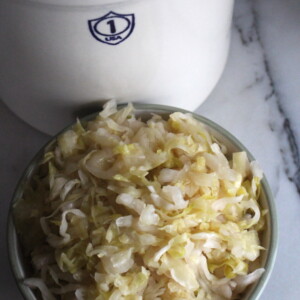Homemade Sauerkraut in a Crock
Making sauerkraut in a crock is the traditional time tested method, and it's easy enough to make at home in a modern kitchen.
Servings: 32 servings (1 gallon of Kraut)
Equipment
Ingredients
- 3 lbs fresh cabbage green, red, or napa
- 4 teaspoons salt approximately 2% of the cabbage weight
Instructions
- Prepare the Cabbage: Slice or chop the cabbage into thin strips. Use a sharp knife, mandoline, or cabbage slicer for best results.
- Add Salt: For 3 lbs of cabbage, add about 4 teaspoons of salt. Mix the cabbage and salt together well, then pound the mixture with a wooden spoon or a sauerkraut pounder for 5-8 minutes to release the cabbage's natural juices.
- Pack the Crock: Transfer the salted cabbage into the 1-gallon fermentation crock, pressing it down as you add it. Continue adding cabbage until the crock is about halfway full.
- Weigh Down the Cabbage: Place a weight on top of the cabbage to keep it submerged. You can use a smaller jar, saucer, or a specialized fermentation weight. If the brine doesn’t fully cover the cabbage, add water until it does.
- Ferment the Sauerkraut: Cover the crock with its lid or a cloth to protect it from dust and pests. Allow the sauerkraut to ferment at room temperature for 3-6 weeks, depending on your taste preference. Warmer temperatures will speed up fermentation.
- Monitor the Brine: Check the sauerkraut daily to ensure the cabbage stays submerged. If needed, top off with water. You may notice small bubbles rising, which indicates fermentation.
- Taste and Store: After about 3 weeks, start tasting your sauerkraut. Once it reaches the flavor and sourness you prefer, move the crock to a cool, dark place (like a basement or refrigerator) to slow down fermentation. Sauerkraut will keep for several months in a cool environment as long as it stays submerged in brine.
Notes
A single three-pound cabbage is usually just about right for a one-gallon fermentation crock. If you have a different sized crock or want to make more or less, adjust your recipe accordingly.
Too Much Salt?
If your sauerkraut tastes overly salty, it could be due to adding too much salt, which can inhibit proper fermentation or make the sauerkraut unpleasantly briny. In that case, you can dilute it slightly by adding more cabbage (if there's room) or adjusting the brine level as needed.
Salt Amount
For a 1-gallon crock using 3 lbs of cabbage, 4 teaspoons of salt is a good starting point, which is approximately 2% of the cabbage's weight. If you don't have a scale, you can use the brine method instead, adding 1 tablespoon of salt per quart of water and pouring that over the cabbage. The exact amount of salt can be adjusted based on taste preferences—some people use as little as 1% salt for a milder flavor, while others go up to 3% for a saltier ferment.Too Much Salt?
If your sauerkraut tastes overly salty, it could be due to adding too much salt, which can inhibit proper fermentation or make the sauerkraut unpleasantly briny. In that case, you can dilute it slightly by adding more cabbage (if there's room) or adjusting the brine level as needed.
Brine Level
Make sure the cabbage remains fully submerged under the brine to avoid exposure to air, which can lead to mold or spoilage. If the brine level drops over time, simply add more water to cover the cabbage. Avoid adding additional saltwater (brine) unless necessary, as this can make the sauerkraut too salty.Fermentation Issues
Slow Fermentation: If the sauerkraut is taking longer than expected to ferment (i.e., no bubbles after several days), it may be due to cool temperatures in the house. If it's too cold, consider moving the crock to a warmer spot, around 65-72°F for optimal fermentation. No Bubbles or Activity: In some cases, you may not notice bubbling, especially in colder environments. This doesn't necessarily mean the sauerkraut isn't fermenting—it could still be fermenting without visible signs. Just be sure to check the water level and the taste periodically. Surface Mold: If any cabbage floats above the brine, it could develop kham yeast (harmless but unsightly) or mold. Make sure the cabbage stays fully submerged under the brine using weights. If mold does appear, scrape it off carefully, being sure the cabbage underneath is still submerged.Storage
After fermentation, store your sauerkraut in a cool place (around 45-60°F) to slow fermentation. A basement, root cellar, or refrigerator works well. Sauerkraut can be kept for 3-5 months in these conditions, as long as it remains under the brine.Nutrition
Calories: 11kcal | Carbohydrates: 2g | Protein: 1g | Fat: 0.04g | Saturated Fat: 0.01g | Polyunsaturated Fat: 0.01g | Monounsaturated Fat: 0.01g | Sodium: 298mg | Potassium: 72mg | Fiber: 1g | Sugar: 1g | Vitamin A: 42IU | Vitamin C: 16mg | Calcium: 17mg | Iron: 0.2mg
